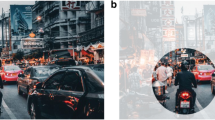Abstract
Seven healthy individuals were recruited to examine the interaction between visual and vestibular information on locomotor trajectory during walking. Subjects wore goggles that either contained a clear lens or a prism that displaced the visual scene either 20° to the left or right. A 5-s bipolar, binaural galvanic stimulus (GVS) was also applied at three times the subject's individual threshold (ranged between 1.2 to 1.5 mA). Subjects stood with their eyes closed and walked forward at a casual pace. At first heel contact, subjects opened their eyes and triggered the galvanic stimulus by foot switches positioned underneath a board. Reflective markers were placed bilaterally on the shoulders as the walking trajectory was captured using a camera mounted on the ceiling above the testing area. Twelve conditions were randomly assigned that combined four visual conditions (eyes closed, eyes open, left prism, right prism) and three GVS conditions (no GVS, GVS anode left, GVS anode right). As subjects walked forward, there was a tendency to deviate in the direction of the prisms. During GVS trials, subjects deviated towards the anode while walking, with the greatest deviations occurring with the eyes closed. However, when GVS was presented with the prisms, subjects always deviated to the side of the prisms, regardless of the position of the anode. Furthermore, the visual-vestibular conditions produced a larger lateral deviation than those observed in the prisms-only trials. This suggests that the nervous system examines the sensory inputs and takes into account the most reliable and relevant sensory input.


Similar content being viewed by others
References
Bent LR, McFadyen BJ, Merkley VF, Kennedy PM, Inglis JT (2000) Magnitude effects of galvanic vestibular stimulation on the trajectory of human gait. Neurosci Lett 279:157–160
Bent LR, McFadyen BJ, Inglis JT (2002) Visual-vestibular interactions in postural control during the execution of a dynamic task. Exp Brain Res 146:490–500
Camis M, Creed RS (1930) The physiology of the vestibular apparatus. Clarendon, Oxford, UK
Cauquil AS, Day BL (1998) Galvanic vestibular stimulation modulates voluntary movement of the human upper body. J Physiol 513:611–619
Day BL, Cauquil AS, Bartolomei L, Pastor MA, Lyon IN (1997) Human body-segment tilts induced by galvanic stimulation: a vestibularly driven balance protection mechanism. J Physiol 500:661–672
Dichgans J, Mauritz KH, Allum JH, Brandt T (1976) Postural sway in normals and atactic patients: analysis of the stabilizing and destabilizing effects of vision. Agressologie 17:15–24
Dickman JD, Correia MJ (1989) Responses of pigeon horizontal semicircular canal afferent fibers. I. Step, trapezoid, and low-frequency sinusoid mechanical and rotational stimulation. J Neurophysiol 62:1090–1101
Fernandez C, Goldberg JM (1976) Physiology of peripheral neurons innervating otolith organs of the squirrel monkey. I. Response to static tilts and to long-duration centrifugal force. J Neurophysiol 39:970–984
Fitzpatrick R, Burke D, Gandevia SC (1994) Task-dependent reflex responses and movement illusions evoked by galvanic vestibular stimulation in standing humans. J Physiol 478:363–372
Fitzpatrick RC, Wardman DL, Taylor JL (1999) Effects of galvanic vestibular stimulation during human walking. J Physiol 517:931–939
Gibson JJ (1958) Visually controlled locomotion and visual orientation in animals. Br J Psychol 49:182–194
Glasauer S, Amorim MA, Vitte E, Berthoz A (1994) Goal directed linear locomotion in normal and labyrinthine defective subjects. Exp Brain Res 98:323–335
Gordon J, Ghilardi MF, Ghez C (1995) Impairments of reaching movements in patients without proprioception. I. Spatial errors. J Neurophysiol 73:347–360
Horak FB, Macpherson JM (1996) Postural orientation and equilibrium. In: Rowell LB, Shepherd JT (eds) Handbook of physiology, sect 12: exercise: regulation and integration of multiple systems. Oxford University Press, New York, pp 255–292
Jahn K, Strupp M, Schneider E, Dieterich M, Brandt T (2000) Differential effects of vestibular stimulation on walking and running. Neuroreport 11:1745–1178
Jahn K, Strupp M, Schneider E, Dieterich M, Brandt T (2001) Visually induced gait deviations during different locomotion speeds. Exp Brain Res 141:370–374
Lee DN, Young DS (1986) Gearing action to the environment. Exp Brain Res Ser 15:217–230
Minor LB, Goldberg JM (1991) Vestibular-nerve inputs to the vestibule-ocular reflex: a functional ablation study in the squirrel monkey. Neuroscience 11:1636–1648
Patla AE (1997) Understanding the roles of vision in the control of human locomotion. Gait Posture 5:54–69
Rogers BJ, Dalton C (1999) The role of (i) perceived direction and (ii) optic flow in the control of locomotion and for estimating the point of impact. Invest Ophthalmol Vis Sci 40:S764
Rossignol S (1996) Visuomotor regulation of locomotion. Can J Physiol Pharmacol 74:418–425
Rushton SK, Harris JM, Lloyd MR, Wann JP (1998) Guidance of locomotion on foot uses perceived target location rather than optic flow. Curr Biol 8:1191–1194
Wilson VJ, Melvill Jones G (1979) Mammalian vestibular physiology. Plenum, New York
Acknowledgements
The authors would like to thank P. Nagelkerke for his technical contributions to this study. This research was supported by the Natural Sciences and Engineering Research Council of Canada grants to J.T.I., I.M.F, and to R.C.
Author information
Authors and Affiliations
Corresponding author
Rights and permissions
About this article
Cite this article
Kennedy, P.M., Carlsen, A.N., Inglis, J.T. et al. Relative contributions of visual and vestibular information on the trajectory of human gait. Exp Brain Res 153, 113–117 (2003). https://doi.org/10.1007/s00221-003-1633-z
Received:
Accepted:
Published:
Issue Date:
DOI: https://doi.org/10.1007/s00221-003-1633-z




